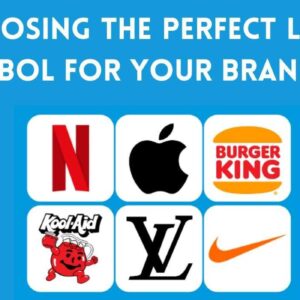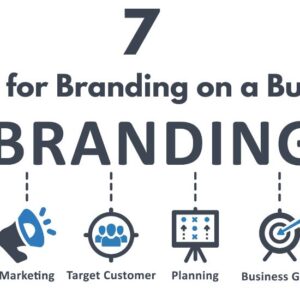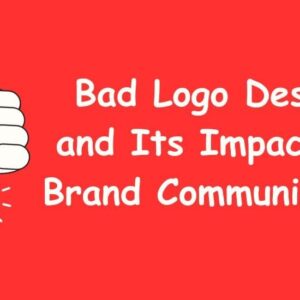Do you dream of building a successful brand but don't know where to start? Do you feel like you are competing against thousands of other companies for customers? Look no further! In this step-by-step guide, we'll take you from zero to hero by teaching you everything you need to know about building a brand that stands out. We'll explore the essential elements of branding, from defining your target audience to creating a unique brand identity. You'll learn how to craft a powerful brand message that resonates with your audience and sets you apart from the competition. We'll also dive into the world of digital marketing, exploring the latest strategies and tools you need to reach your target audience and build a loyal following. Whether you're a small business owner, an entrepreneur, or just starting out, this guide will provide you with the knowledge and skills you need to build a brand that drives success. So let's get started on your journey from zero to hero!
The Importance of Branding
Branding is more than just a logo or a catchy tagline; it's the essence of your business. Your brand represents who you are, what you do, and how you do it. A promise is a contract. Your brand promises something to your customers, and you are accountable to them when you don't deliver. A strong brand is essential to building trust and credibility with your target audience. It sets you apart from the competition and creates a connection with your customers.
To understand the importance of branding, consider some of the most iconic brands in the world, such as Apple, Nike, and Coca-Cola. These brands have become household names not just because of their products but because of their strong brand identities. They have created a sense of loyalty and emotional attachment with their customers, which drives brand awareness and sales.
Your brand is your most valuable asset, and it's essential to invest in it from the start. Creating a strong brand takes time, effort, and knowledge. Pursuing this goal is worth it for the rewards you'll receive. A strong brand can help you attract new customers, retain existing ones, and build a loyal following that will support your business for years to come.
Branding Strategy: Define Your Brand Identity
Identifying your brand persona is indeed an essential first step in branding your company. It involves understanding your brand's values, personality, and voice to create a consistent and recognizable image that resonates with your target audience. Here are some steps to help you identify your brand persona:
- Determine your brand's values: Think about what your company stands for, what its core values are, and what kind of impact you want to make on your audience. These values should guide everything you do and be reflected in your brand's persona.
- Define your target audience: A brand persona should be crafted with the target audience in mind so that it resonates with them. Consider the demographic and psychographic traits of your ideal customer, such as age, gender, interests, beliefs, and behaviors.
- Develop a brand personality: Think of your brand as a person and give it a personality that reflects your values and resonates with your target audience. For example, is your brand serious or playful? Professional or friendly? Innovative or traditional?
- Craft a brand voice: Your brand voice is how your brand communicates with your audience. Determine whether your voice is formal or informal, authoritative or approachable, and so on. Consistency is key here; your voice should remain consistent across all marketing channels.
- Test and refine: Once you have developed your brand persona, test it with your target audience to see how well it resonates. You may need to refine your brand persona as you get feedback and adjust your strategy accordingly.
By taking the time to identify your brand persona, you can create a more cohesive and effective branding strategy that will help your company become more successful and profitable. Brand identity refers to the visual and communicative elements that represent your company's values, mission, and personality. It encompasses everything from your logo and color scheme to your messaging, tone of voice, and the overall look and feel of your brand. A strong brand identity helps to differentiate your business from competitors and build recognition and trust with your target audience. It should also be unique and memorable.
You might want to define your brand identity by answering these questions:
- What is your mission?
- What are your core values?
- What is your unique selling proposition (USP)?
- What is your brand personality?
Your mission is your reason for existing as a brand. It's the purpose behind your business, and it should guide everything you do. Your business's core values define its practices and performance. They should be the foundation of your brand and guide your decision-making. Your unique selling proposition is what defines you and differentiates you from your competitors. Brand personality refers to the set of human traits and characteristics that a brand is associated with. These traits can be used to describe the brand's personality and can help to create a connection with customers. Some common brand personality traits include sincerity, excitement, competence, sophistication, and ruggedness. By embodying specific personality traits, a brand can appeal to specific customer groups and build a strong emotional connection with its audience. It should be aligned with your target audience and reflect your company culture.
Once you have defined your brand identity, you can start crafting your brand message and positioning.
Research your target audience to develop a marketing strategy.
Successful branding requires an in-depth understanding of the true needs and desires of your audience. Your target audience is the group of people who are most likely to buy your products or services. They are the most likely audience to understand and appreciate your brand message.
A customer persona is indeed an effective way to research your target audience. It involves developing a fictional character that represents your ideal customer and understanding their needs, wants, pain points, and behaviors. Here are some steps to help you create a customer persona:
- Gather data: Start by collecting data on your existing customers, such as their age, gender, income, education level, job title, interests, and buying habits. You can do this through surveys, customer interviews, social media analytics, and website analytics.
- Identify patterns: Look for patterns and similarities among your customers' data to identify the most common characteristics of your target audience. By creating a persona for your ideal customer, you can better understand this group's needs and expectations.
- Develop the persona: Use the data you have collected to create a fictional character that represents your ideal customer. Give them a name, job title, demographic information, interests, and behaviors.
- Add detail: Add more detail to your persona by including information about their motivations, pain points, goals, and challenges. This will help you better understand their needs and how to address them.
- Use the persona: Once you have created your persona, use it to guide your marketing and sales efforts. Use the persona to inform your messaging, content, and marketing channels to ensure that you are reaching your target audience effectively.
Creating a customer persona allows you to get a deeper understanding of your target audience and tailor your marketing efforts to their specific needs and preferences. By taking the time to research your target audience and create a persona, you can increase your chances of success and build stronger relationships with your customers. Once you have created your customer persona, you can start researching their needs and preferences. Surveys are most effective when they collect feedback. Focus groups and social media listening can also provide valuable information. The more you know about your target audience, the better you can tailor your brand message to their needs and preferences.
Develop Your Brand Message and Positioning
Your brand message is the core message that you want to communicate to your target audience. It should be simple, clear, and memorable. Your brand positioning is how you want to be perceived in the market. It's your unique value to your customers that makes you a valuable company.
To craft your brand message and positioning, start by identifying your unique selling proposition (USP). Your unique selling proposition is the reason why your company stands out from competitors. It should be the focus of your brand message and positioning.
Once you have identified your USP, you can start crafting your brand message. Your brand message should be based on your USP and should communicate the benefits of your products or services. It should be tailored to your target audience and should be consistent across all your marketing channels.
Your brand positioning should be based on your brand identity and should reflect your USP. It should also be unique and memorable. Your brand positioning should guide all your marketing efforts and should be the foundation of your brand strategy.
Design Your Brand Identity: Logo, Color Scheme, Typography, and Imagery
A brand identity gives your company an instantly recognizable personality that draws people in and helps them develop a lasting impression in a competitive market. Your brand identity should be consistent across all your marketing channels and should reflect your brand personality.
To design your brand identity, start by creating a logo. Your logo should be recognizable and your brand memorable. It should reflect your brand personality. It should be designed to work across all your marketing channels, including your website, social media, and print materials.
Your color scheme should be based on your brand personality and should be consistent across all your marketing channels. Your typography should be easy to read and reflective of your brand personality. Your imagery should be high-quality and reflective of your brand message.
Once you have designed your brand identity, you can create a brand style guide.
Create a Brand Style Guide
A brand style guide is a document that outlines your brand identity and provides guidelines for how it should be used. Designing a logo is an essential first step in the process. A logo helps you stand out while conveying key information about your business, as well as guidelines for how they should be used in different contexts.
Your brand style guide should be comprehensive and should be shared with all your employees and partners. It should be updated regularly to reflect any changes in your brand identity.
Build Your Brand Online: Website, Social Media, and Content Marketing
Building your brand online is essential to reaching your target audience and building a loyal following. Your online presence includes your website, social media, and content marketing.
Your website is a central point of contact for potential customers. It should be easy to navigate, visually appealing, and reflective of your brand identity. To get the most out of your website, it's important to make sure it's well-optimized for both search engines and mobile devices.
Your social media presence should be tailored to your target audience and should be consistent with your brand identity. It should include the platforms where your target audience is most active, such as Facebook, Instagram, and Twitter.
Your content marketing should be informative, engaging, and reflective of your brand message. It should be tailored to your target audience and should be optimized for search engines and social media.
Build Your Brand Offline: Events, Sponsorships, and Collaborations
Building your brand offline is just as important as building it online. Offline activities can help you reach new customers and build relationships with existing ones. Some offline activities to consider include events, sponsorships, and collaborations.
Events are a great way to showcase your products or services and connect with your target audience. They can be in-person or virtual and can range from product launches to networking events.
Sponsorships are another way to build your brand offline. They can include sponsoring events, teams, or individuals that align with your brand values.
Collaborations are another way to build your brand offline. They can include partnering with other businesses or individuals to create new products or services.
Measure Your Brand Success: KPIs and Analytics
To measure the success of your brand, you need to track key performance indicators (KPIs) and analytics. KPIs are metrics that measure the success of your marketing efforts, such as website traffic, social media engagement, and sales. Analytics are data that provide insights into how your target audience is interacting with your brand.
To track KPIs and analytics, use tools such as Google Analytics, social media analytics, and email marketing software. Regularly review your data to identify areas of improvement and adjust your brand strategy accordingly.
Avoid these common branding mistakes to ensure your brand is seen as professional.
Building a successful brand takes time and effort, and it's easy to make mistakes along the way. Some common branding mistakes to avoid include:
- Not knowing who your target audience is, or how to reach them
- Not being consistent with your brand identity
- Not tailoring your brand message to your target audience
- Not investing in your brand
- Not measuring your brand's success can lead to disaster.
By avoiding these mistakes, you can build a strong brand that drives success.
Conclusion: Takeaways and Next Steps
Building a successful brand takes time and effort, but the rewards are worth it. By following the steps outlined in this guide, you can build a brand that stands out and drives success. Remember to define your brand identity, research your target audience, craft a powerful brand message, and design a memorable brand identity. Build your brand online and offline, measure your success, and avoid common branding mistakes. By investing in your brand from the start, you can build a loyal following that will support your business for years to come.





